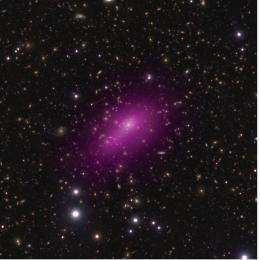In this optical and X-ray image of galaxy cluster Abell 2219, X-ray brightness from the Chandra X-ray observatory (pink) is superimposed on an optical image showing the distribution of starlight and galaxies in the cluster. The very hot gas that fills the cluster shines brightly at X-ray wavelengths. (Image courtesy Anja von der Linden et al.)
(PhysOrg.com) -- Through observations of massive galaxy clusters, scientists have made the most precise measurements to date of the effects of dark energy and gravity on cosmological scales. This work is an important step toward understanding why the expansion of the universe is accelerating. Something is pushing our universe apart, faster and faster, with each passing moment, and future work using similar methods should determine whether that something is dark energy or a change in the way gravity works on cosmological scales.
The analysis, contained in four papers published this month in the Monthly Notices of the Royal Astronomical Society, was led by a team based at the Kavli Institute for Particle Astrophysics and Cosmology, located at the Department of Energy's SLAC National Accelerator Laboratory and Stanford University.
Clusters of galaxies, the largest gravitationally bound objects in the universe, began forming about 10 billion years ago. Because it takes a long time for light from the farthest reaches of the universe to arrive at Earth, the most distant clusters appear as they did when they were much younger, while the closest ones look more their actual ages. By looking at clusters both near and far, researchers were able to study the evolution of clusters and deduce how changes in the universe over billions of years helped shape their growth. The results offer insights into the forces that made the universe we see today.
"As space expands faster and faster, it becomes more difficult for gravity to pull matter together and form structures such as galaxy clusters," said lead author Adam Mantz, a researcher at NASA's Goddard Space Flight Center and former graduate student at KIPAC. By observing clusters at a range of distances, the researchers found that the present-day universe contains fewer clusters than would be expected if the expansion of the universe weren't accelerating.
"At the same time," Mantz said, "whatever is causing the acceleration leaves a distinctive fingerprint on the resulting cosmic structure." Searching for a match to that fingerprint, the researchers compared their observations of galaxy clusters with various models of dark energy, a form of energy theorized to permeate all of space and drive the universe's accelerated expansion. Although the general idea of dark energy is relatively well accepted, there are a variety of models that try to explain what it is and how it works, and a detailed understanding remains elusive.
By combining their observations of galaxy clusters with other cosmological data, the scientists made the most precise dark energy measurements to date. The new measurements are consistent with the simplest model, in which dark energy is a "cosmological constant"—an energy field that is uniform throughout space and time. The idea of a cosmological constant was introduced by Albert Einstein in 1917, but soon fell out of favor. In recent years, the idea has become popular again as a way of explaining the accelerating expansion of the universe.
The observations also weigh against so-called “modified gravity" models, in which gravity is either stronger or weaker than predicted by Einstein’s Theory of General Relativity. The new results show that the growth of cosmic structure is consistent with the predictions of General Relativity, supporting the view that dark energy drives cosmic acceleration.
“Measuring the histories of both cosmic expansion and structure growth allows us to start to distinguish between different dark energy and modified gravity scenarios,” said co-author David Rapetti of KIPAC, who is leading efforts to constrain modified gravity models.
Building on previous work that had examined only small patches of sky, the new study used data from the ROSAT satellite and NASA's Chandra X-ray observatory, which record X-rays emitted by the hot, multi-million-degree plasma that fills galaxy clusters.
"By searching the entire sky for this X-ray emission, we have identified the rarest and most massive clusters, which provide the cleanest and strongest cosmological signal," said Harald Ebeling of the University of Hawaii's Institute for Astronomy, a coauthor on the papers. In addition to its large data set, the research incorporates modeling advances that make the results more robust.
Over the past decade, observations of supernovae, the cosmic microwave background and galaxies, as well as earlier X-ray observations of clusters, have all pointed to an accelerated expansion. Independently detecting the effects of acceleration on the growth of clusters provides an important consistency check.
"The suite of cosmological observations probe different physical systems, so the agreement between them is very encouraging," said co-author Steven W. Allen, associate professor of physics at KIPAC. "The combination of high quality and complementary observations offers our best chance to understand cosmic acceleration."
Provided by SLAC National Accelerator Laboratory




















